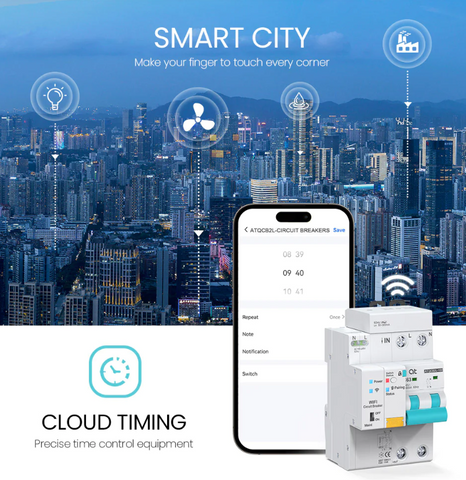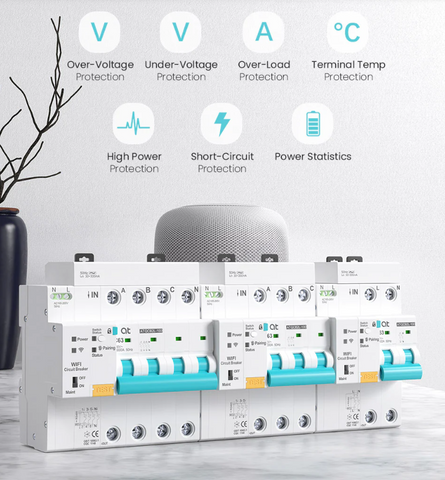Smart Breaker: Pros and Cons They Don't Tell You
As technology advances, "smart homes" are becoming more popular as they integrate into every part of our lives. Smart devices offer convenience, energy efficiency, and the promise of a more connected lifestyle. Among these innovative gadgets, the smart breaker stands out as a crucial component of a modern smart home.
Designers make smart breakers to replace old circuit breakers on smart electrical panels, giving more control over your electrical system. In this blog, we'll discuss the advantages and disadvantages of smart breakers that manufacturers may not tell you about initially. This will help you make an informed choice about using them in your home.
What is a Smart Breaker?

A Smart Breaker is an advanced electrical circuit breaker with technology and connectivity features for better control and functionality. The product replaces circuit breakers and has remote monitoring, load management, and improved safety features.
A smart circuit breaker can be remotely controlled and monitored, making it one of its key features. By monitoring and controlling power and electrical circuits, users can effectively manage their energy usage and reduce their electricity bills. In terms of safety, Smart Breakers offer advanced protection features. They can detect and respond to electrical faults, such as short circuits or overloads, in real time.
Furthermore, smart home systems can integrate Smart Breakers, enabling seamless automation and integration with other smart devices. They can work with smart thermostats, lighting systems, or security systems to make personalized energy-saving and safety plans. This integration enhances the overall efficiency and convenience of managing a smart home.
Pros of Smart Breakers

1. Remote Control
One of the most significant advantages of smart breakers is the ability to control your electrical system remotely. Homeowners can use mobile apps or home automation to control circuits remotely and monitor their status globally. This remote control feature is very convenient.
The remote control feature is convenient. You can use it to turn off appliances you forgot to switch off. You can also use it to disable circuits for added security while on vacation.
2. Energy Monitoring
Smart breakers often come equipped with energy monitoring capabilities. They can track the electricity consumption of each circuit, providing detailed insights into your energy usage. This data empowers you to identify power-hungry devices, optimize your energy consumption, and ultimately save money on your utility bills.
3. Fault Detection
Unlike traditional breakers that only trip when an overload occurs, smart breakers can detect various electrical faults more accurately. These smart devices quickly stop the power to a circuit if there's a short circuit or ground fault. This lowers the chance of electrical dangers and harm to your appliances.
4. Notifications and Alerts
Smart breakers can send real-time notifications and alerts to your smartphone or email when they trip or encounter any issues. This feature helps you quickly identify and resolve problems, ensuring the safety of your home and its occupants.
5. Time-of-Use Optimization
Utility companies' time-of-use pricing models work in conjunction with some smart breakers. Save money by doing energy-intensive tasks when electricity is cheaper, optimizing your energy usage and potentially lowering costs.
6. Integration with Smart Home Ecosystems
Smart breakers can seamlessly integrate with other smart home devices and platforms. You can use this integration to create personalized automation routines. For example, you can turn off lights and appliances when you leave or adjust the thermostat based on energy usage patterns.
Cons of Smart Breakers

1. Cost
One of the most significant drawbacks of smart breakers is their cost. Compared to traditional breakers, smart breakers can be substantially more expensive. Additionally, if you're retrofitting an existing electrical panel, installation costs can further increase the overall investment.
2. Compatibility and Wiring
Smart breakers might not be universally compatible with all electrical panels. Depending on the make and model of your panel, you may face limitations in choosing the right smart breaker. Furthermore, installation could be complex and may require professional expertise, especially if your home's electrical wiring needs modifications.
3. Dependence on Technology
As with any smart device, smart breakers are reliant on technology and internet connectivity. If there's a power outage or a failure in your home network, you may temporarily lose remote access and control over your electrical system.
4. Learning Curve
Operating a smart breaker system involves a learning curve, especially for individuals who are less tech-savvy. Setting up the smart breaker may require time and patience. Additionally, it is necessary to connect it with other smart home devices. Lastly, one must learn how to use the app or platform.
5. Privacy and Security Concerns
Connecting your electrical system to the internet raises potential privacy and security concerns. Smart breaker manufacturers maintain good security, but hackers can still compromise any device connected to the internet.
6. Limited Market and Support
Smart breakers are still a relatively new technology, and their market may not be as extensive as other smart home devices. Consequently, finding replacement parts or receiving technical support could be challenging in some regions.
What to Recommend-- ATQCB2L Smart Circuit Breaker RCBO

The ATQCB2L smart breaker that I recommend is a game-changer in the field of electrical systems. This device is important for modern homes. It has advanced features such as overload protection, remote control, energy monitoring, and compatibility with smart home systems. By using this smart breaker, we can make our homes safer, more convenient, and more energy efficient, which improves our lives.
One of the key features of this smart breaker is its ability to detect and prevent electrical overloads, overcurrent and earth leakage. It constantly monitors the electrical load and automatically shuts off the power supply if it exceeds the safe limit. This keeps our appliances safe and prevents electrical fires, keeping our homes and loved ones secure.
This smart breaker lets us control our home's electrical system from anywhere using a smartphone or tablet. We can easily switch off lights, appliances, or other electrical devices that were accidentally left on. This helps save energy and reduce our bills.
Furthermore, this smart breaker is equipped with advanced energy monitoring features. This enables us to make informed decisions and reduce our overall power consumption. This not only helps us save money but also contributes to a greener and more sustainable environment.
Another notable feature of this smart breaker is its compatibility with smart home systems. It works well with smart home systems like Amazon Alexa or Google Home, allowing voice control and automation of our devices. We can make schedules to control appliances and lights, making our daily routines more convenient and efficient.
Conclusion
Smart breakers offer undeniable advantages in terms of remote control, energy monitoring, and safety features. However, their higher cost, compatibility issues, and potential dependence on technology might give some homeowners pause. Before deciding, think about your needs and preferences, and consider the advantages and disadvantages of investing in a smart home.
As technology advances, smart breakers could become cheaper and more available, possibly overcoming current limitations. For now, early adopters of smart breakers can enjoy the benefits of enhanced control and energy efficiency in their homes.
Contact:
AT-ELE
sale@at-ele.com
www.at-ele.com



